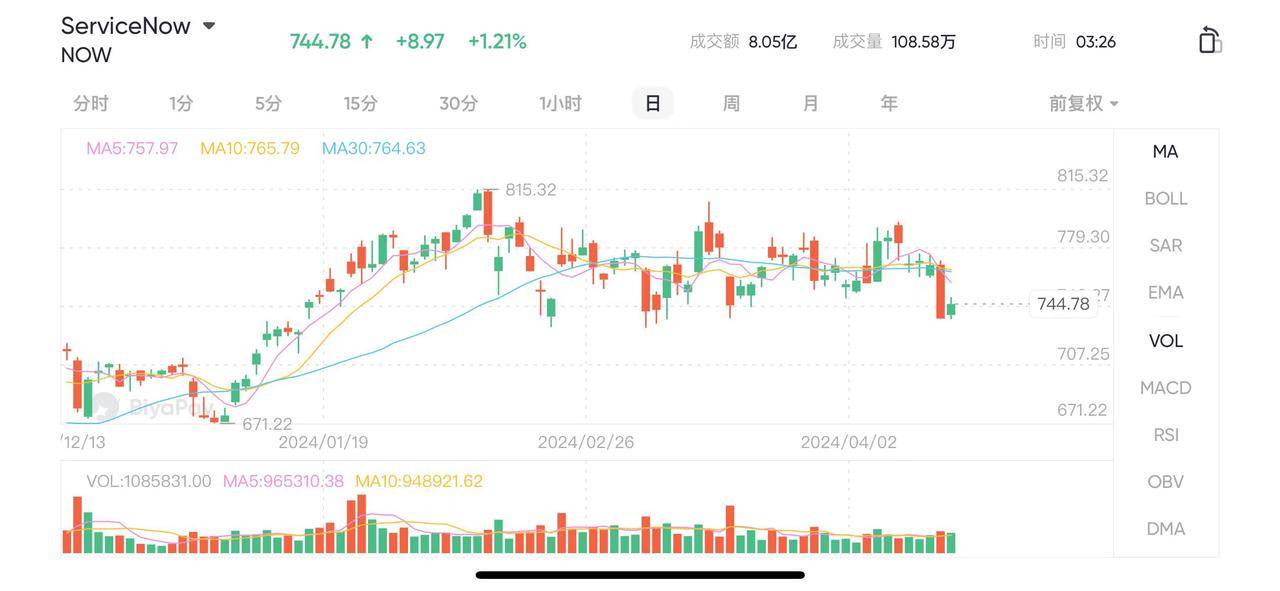- Remittance
- Exchange Rate
- Stock
- Events
- EasyCard
- More
- Download
- Creator

ServiceNow, the AI Stock You Can't Afford to Miss—Soaring 1000% in Ten Years, It's Time to Get On Bo
**Which stock has risen rapidly from the cold winter? **
**Yes, it’s the superhero from the IT world—ServiceNow! Also, it is a growth AI (Artificial Intelligence) stock! **

We all know that currently, Nvidia is one of the hottest AI stocks on the market, but as investors, we should also diversify our portfolios.
For example, billionaire hedge fund manager Dan Loeb, in a letter to clients last year, compared AI to the Industrial Revolution. The characteristic of the Industrial Revolution was that as machines replaced human workers, economic output increased dramatically. AI is expected to achieve similar step-like productivity improvements in nearly all industries.
Loeb wrote, “We have witnessed the development of AI and believe that this technology has matured to the extent that it drives the transformation of technology platforms, similar to the technological platform transformations that occur about every decade: personal computers in the 1980s, the internet in the 1990s, mobile devices in the first decade of this century, and cloud computing in 2010.”
This undoubtedly presents a huge opportunity for investors. The most prudent way to profit is to hold a basket of AI stocks. Of course, many investors are naturally drawn to Nvidia, as the company’s chips power the most advanced AI systems. However, considering the current stock price, ServiceNow is a more attractive AI stock.
Why is that so?
Nvidia’s stock seems too expensive
Nvidia’s GPUs (graphics processing units) are the gold standard for accelerating complex data center workloads such as AI. The company continues to set records on MLPerf (an objective benchmark measuring AI hardware and software performance). Additionally, The Wall Street Journal reported that “Nvidia’s chips underpin all the most advanced AI systems, with an estimated market share of over 80%.”
Nvidia’s financial performance in the fourth quarter of last year was staggering. Driven by strong demand for AI solutions, data center sales grew by triple digits, revenue surged 265% to $22.1 billion. Meanwhile, driven by pricing power and software business, non-GAAP (generally accepted accounting principles) net profit grew by 486%, diluted earnings per share reached $5.16, and the gross margin increased by more than 10 percentage points.
According to Grand View Research, AI spending is expected to grow at a rate of 37% per year by 2030. Nvidia will undoubtedly benefit from this tailwind. In fact, Wall Street expects the company’s annual sales to grow by 27% over the next five years. But this general estimate makes its current valuation of 36.6 times seem too high.
It must be said, I am not advising investors to sell Nvidia’s stock. After all, it is an excellent company with a history of cutting-edge innovation and good prospects for future growth. However, I doubt whether it can bring returns above the market with its current stock price. Therefore, as investors, we should also consider other AI stocks.

About ServiceNow’s Legendary Story
From last October to now, this stock has grown nearly 70%, and over ten years, it has successfully achieved a 1000% increase, creating a fabulous comeback story! It’s like a myth in the stock market, each step filled with surprises and passion! It can be said to be a once-in-a-decade investment opportunity.
So, what established the foundation of ServiceNow? Why was it able to rise quickly? And how did it become a more attractive AI stock?
Firstly, what made ServiceNow?
“It was November 5, 2003. I knew we had to start a company before I turned fifty because a fifty-year-old can’t start a company. So, at the age of 49—November 24 is my birthday—we started,” recalled Fred Luddy, founder of ServiceNow, about establishing ServiceNow.
ServiceNow aimed to solve a simple problem initially because IT issues were too complicated for ordinary workers. Fred Luddy wanted to create a simple and flexible workflow, allowing employees to easily manage their IT requests.
His vision, with the help of his team, was realized.
ServiceNow’s IT tools do not require IT department setup. Once operational, by providing a single request, data point, and checklist collection center, it could be analyzed by algorithms to predict needs, mark concerns, and measure efficiency.
Their innovation premium key came from two scalable product features: simplicity and customizability.
It was precisely these two features that were executed to perfection. In a business where renewal rates are typically at least 90%, ServiceNow stood out with a 98% renewal rate, becoming a leader in winning customer trust. When ServiceNow’s annual revenue doubled every year, started making profits, and had a team of 100 employees, Luddy set aside his pride and decided to find a successor for himself. He understood the product but needed a CEO who understood growth.
At that time, he found Frank Slootman, a resolute and decisive executive who had led Data Domain to go public and then sold it to EMC. Frank was very good at building sales teams and had the advantage in IT services, knowing how to tailor products for larger, higher-paying customers.
Luddy did not misjudge. To win big clients like Johnson & Johnson, Frank repositioned ServiceNow, turning it from just an IT helpdesk solution that excites CEOs at meetings into a comprehensive toolkit that meets CIO needs and addresses any of their challenges.
Meanwhile, Frank’s assertive style also brought unprecedented execution capability and a clear development path to ServiceNow. Around 2012, Frank, with his unique leadership, took ServiceNow to the New York Stock Exchange and personally participated in the IPO bell-ringing ceremony.
By 2016, ServiceNow’s operating income reached $1.39 billion, with a market value of $12.34 billion. At that time, the ServiceNow team saw a bigger vision. Why should the company’s products only serve IT departments? ServiceNow’s software and reputation meant it could expand into other areas, from customer service to human resources.

The Gorgeous Turnaround of IT Process Software
The CEO changed again, bringing in former eBay CEO John Donahoe, while Luddy was promoted from Chief Product Officer to Chairman of the company, overseeing the overall situation. John didn’t have an IT background; he was the former CEO of consulting giant Bain. However, his thinking aligned with the company’s vision: to make complex processes simple and straightforward. “Consumers want a seamless experience, and so do employees.”
During this period, ServiceNow’s special advantage was leveraging its dominant position in IT services to increase sales and use of related products among existing customers. Thus, John extended ServiceNow’s networked and user-friendly IT support systems into various business processes of enterprises, such as human resources, finance, etc. This approach increased sales by 30% that year.
At this time, emerging technologies were also brought into the company’s development grand plan. The company not only simplified services but also hoped to improve automation and analytics through artificial intelligence, while mobile apps also provided a higher market penetration rate. “This isn’t technology for technology’s sake,” John said. “We want to improve the quality of life at work, what they call employee experience, but to me, it’s productivity.”
As ServiceNow delved deeper into ERP and platformization, the company welcomed its fourth CEO, McDermott. This CEO was a leading figure at ERP giant SAP, where his historical performance was outstanding—whether it was elevating a weak division into the company’s top-selling department or growing the revenue of one of the world’s largest software companies from $14.8 billion to $29 billion over ten years.
After McDermott took office, besides continuing to maintain technological innovation leadership and customer priority, he also maintained high growth rates in recent years through internationalization. As ServiceNow ventured into new markets such as South Korea, India, and Latin America in search of customers, sales records continued to be broken. Now, McDermott has a new goal: to make ServiceNow “a model of a 21st-century enterprise software company.” Discussing customers in 2023, McDermott stated, “We are now in a platform economy.”
Just as McDermott believes, ServiceNow is now not only buying applications from large software companies but also creating a large number of applications. Not only that, McDermott also believes that in the next two years, there will be over 750 million applications on ServiceNow. Perhaps by then, this company will truly be regarded as a legend.
Now, let’s talk about ServiceNow’s advantages in artificial intelligence
Digital transformation (DX) should be an important driving force for ServiceNow. International Data Corporation estimates that as enterprises digitize all processes to improve efficiency, digital transformation spending will grow at an annual rate of 16% by 2027. Given ServiceNow’s leadership position in many related markets, it is ideally positioned to benefit from this long-term trend.
In addition, generative AI should also be an important driving force. Last September, ServiceNow launched Now Assist, becoming one of the first software companies to offer generative AI to customers. Now Assist is a set of tools that can automatically perform tasks and boost productivity for IT services, customer service, human resources, and development teams. Bloomberg Intelligence estimates that by 2032, revenue from generative AI software will grow at an annual rate of 58%.
ServiceNow CEO Bill McDermott commented on these favorable factors during a recent earnings call:
What we are seeing now is a strong, enduring market, driven by a once-in-a-generation long-term trend. For years, ServiceNow has been investing, innovating, and preparing for this wave, and that’s why we caught it so early. AI is injecting new fuel into our already excellent growth engine.
Considering this, Wall Street expects ServiceNow’s sales to grow at an annual rate of 20% over the next five years. In this context, through the multi-asset trading wallet BiyaPay App, it can be seen that its current valuation of 17.4 times is acceptable. Use BiyaPay to search its code for online real-time trading. You can also deposit digital currency (U) into BiyaPay, then withdraw fiat currency to other securities to invest in U.S. stocks. Thus, investors with a five-year investment horizon should feel confident buying into this growth stock today.

At this point in the story, we can see that ServiceNow is a truly high-quality enterprise. In 2023, ServiceNow’s technology services market was valued at a massive $24.8 billion. By 2033, this market is expected to soar to an astonishing $123.2 billion! That’s a compound annual growth rate of 17.4%, a growth where companies in this market are like taking an elevator, which is much faster than climbing stairs.
From the following data, it can also be seen that it is a continuously growing company.
- Annual revenue in 2022 was $72.45 billion, an increase of 22.88% from 2021.
- Annual revenue in 2021 was $58.96 billion, an increase of 30.47% from 2020.
- Annual revenue in 2020 was $45.19 billion, an increase of 30.61% from 2019.
No wonder these robust and steady major shareholders, like grabbing New Year’s goods during the festival, tightly hold onto their shares! From these comprehensive factors, it can be seen that the company’s continuous growth is not accidental, but based on accurate market insights, effective corporate strategies, reasonable business models, excellent product quality, and a high regard for customer service. This series of stacking advantages has allowed ServiceNow to gain unanimous market recognition even in the capital winter of today.

























